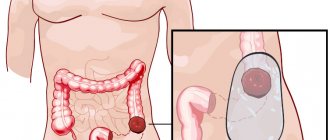In this article we will figure out whether hemorrhoids can turn into cancer.
Hemorrhoids are varicose transformations of the vessels of the rectum in the form of their extensions, called hemorrhoids. These formations can be internal and external, and at advanced stages of the pathological process, the nodes begin to fall out and bleed.
The disease usually progresses in waves: chronic periods are replaced by acute ones, and vice versa. The remission period can be almost painless, and the patient does not experience pathological symptoms or complications.
Stages of the disease
Main stages of the disease:
- formation of external and internal hemorrhoids;
- periodic loss of nodes and independent reduction;
- prolapse and return of nodes to their place is carried out with additional medication and is accompanied by periodic bleeding.
Periods of exacerbation of hemorrhoids are characterized by a number of complications, of which the most common are considered to be thrombosis of the hemorrhoid, swelling and inflammation of adjacent tissues and mucous membranes.
Many people wonder whether hemorrhoids can turn into cancer?
Characteristics of rectal cancer
Malignant processes in the rectum are characterized by the development of oncological formations originating from the epithelial tissues of the walls of the rectum. Over time, metastases begin to form - screenings from the main focus of the pathological process, which have the ability to grow and affect other organs. The structure of metastases is similar to the main tumor.

How to distinguish colon cancer from hemorrhoids? More on this below.
Initially, metastases develop around the lymph nodes, and as the disease becomes more complicated, they develop in the lymph nodes themselves. In this case, the lesion affects most of the intestine. The next stage is the spread of cancer to neighboring organs, which significantly impairs their functions. The lungs, pelvic bones, bladder, and uterus have the highest probability of metastases settling. At the last stage of its development, cancer is incurable and leads to death.
So, can hemorrhoids turn into cancer? What are the signs of this?
Rectal prolapse
With this pathology, the rectum extends partially or completely beyond the anus. Sudden rectal prolapse almost never occurs and the condition usually develops gradually.
This disease is similar to hemorrhoids in the following manifestations:
- sensation of a foreign body in the intestines;
- pain and discomfort that increases with defecation;
- bloody and mucous discharge;
- Initially, the mucous membrane falls out only during bowel movements, while it is reduced on its own, gradually it ceases to be reduced by itself and the patient has to do this with his hands.
The difference in the symptoms of these diseases is that with hemorrhoidal disease, the rectal nodes that form near the anus fall out, and with rectal prolapse, the part of the rectum that is located above the anal canal comes out.
A pathology similar in symptoms to hemorrhoids - the rectum extends partially or completely beyond the anus.
One pathology can be distinguished from another by the location of the folds of the mucous membrane - in the case of hemorrhoids they are longitudinal, in case of prolapse they are transverse.
More information about diseases of the rectum and the features of their treatment can be found in this article.
Similarity of symptoms
In the early stages of the development of such diseases, the symptoms of the pathological process are quite similar. Their list includes:
- bleeding from the rectum or blood-stained stool;
- false urge to defecate;
- discomfort or pain in the anorectal area.
If such signals appear, you should immediately consult a doctor to diagnose the pathology in order to determine whether it is hemorrhoids or cancer.
How often do hemorrhoids turn into cancer? Let's figure it out.

Features of oncology
Malignant inflammation of the rectum is an oncological tumor of the mucous membrane. Pathology has causes:
- unbalanced diet;
- abuse of alcohol and tobacco products;
- ulcerative colitis;
- anal fissures;
- inflammatory processes;
- intestinal polyps;
- proctitis;
- thrombosis of the hemorrhoid;
- obstruction of hard feces;
- obesity;
- heredity;
- stressful condition.
The cause of rectal cancer is an insufficient amount of nutrients in the mucous membrane, weakened immunity. An unbalanced diet, bad habits, and pathologies of the gastrointestinal tract are the etiology of the accumulation of solid feces, the toxic substances of which cause the formation of polyps and metabolic disorders.
We recommend reading: Life after gallbladder removal: rehabilitation, recovery during the postoperative period, rules and possible complications
The first stage of cancer has no obvious signs. The main symptoms of cancer as the pathology progresses are:
- unstable stool: diarrhea followed by constipation;
- false urge to defecate;
- thin feces;
- discomfort during the act of defecation;
- discharge of blood from the anus;
- increased gas formation;
- vomit;
- weight loss;
- pale skin;
- fatigue, lethargy;
- hyperthermia;
- aching joints.
Rectal cancer is characterized by signs of intoxication of the body. This is due to the appearance of atypical cells that secrete pathogenic substances during cancer. An increase in malignant tumor leads to intestinal obstruction, and as a result, constipation, which is accompanied by bloating, flatulence, and intestinal spasms.
Cancer is a factor in changes in the hormonal levels of internal secretion, decreased immunity, and poor blood clotting.
Hemorrhoids and rectal cancer are pathologies, untimely detection of which leads to complications. Inflammation of the external and internal nodes of the anal canal does not pose a mortal danger to the patient; the development of a malignant tumor is fatal. Correct determination of the etiology of the observed symptomatic signs of rectal pathology makes it possible to make an accurate diagnosis and prescribe effective treatment.
Differences in symptoms
Hemorrhoids and rectal cancer have significant differences, and they lie mainly in symptoms.
Differences between cancer and hemorrhoids:
- The nature of the bleeding. With the development of hemorrhoids, the blood has a bright red (scarlet) color and is released, as a rule, at the end of the act of defecation, which can be visually determined by the feces - the blood is most often on the surface and often looks like a clearly defined strip. In case of malignant processes in the rectum, the blood is predominantly dark in color and mixes evenly with feces. How often do hemorrhoids turn into cancer? We will answer this question.
- The nature of discharge during defecation. In case of cancer, before bowel movement, mucus or pus is sometimes released from the rectum, and in some cases, particles of the malignant neoplasm itself when it is damaged. In addition, there may be a change in the shape of feces - the development of a tumor often leads to the formation of ribbon feces. With hemorrhoids, such symptoms are not observed.
- Nature of constipation. Oncological disease is often accompanied by longer-term constipation than with hemorrhoids. The patient may not have a bowel movement for more than two days.
- General condition of the patient. Sudden weight loss, loss of appetite, pale skin, constant pain in the abdomen, fever, constant feeling of fatigue, shortness of breath and weakness - such symptoms can only occur with oncology and are rarely observed with hemorrhoids.
- The nature of the formations. Hemorrhoids, unlike a malignant tumor, prolapse from the rectum.

In addition, in cases where polyps were previously identified in the patient (which should be recorded in the medical history), the likelihood of developing cancer pathologies increases. Many people think that hemorrhoids can develop into cancer, how can this be detected?
The difference between cancer and hemorrhoids
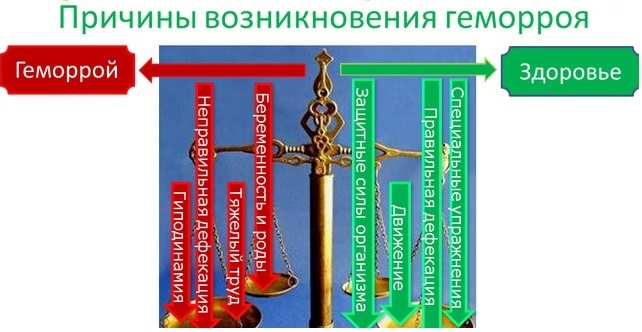
Thirdly, with rectal cancer, mucus may come out immediately before stool is released. It is often combined with pus and has an unpleasant odor. In addition, with cancer, small fragments of the tumor itself are sometimes found in the stool. This is observed when she is traumatized. Fourthly, the character of the chair itself is an important distinguishing criterion. As the tumor grows, the lumen of the intestine decreases, making it difficult for stool to pass through. The stool takes on a ribbon-like shape (about the thickness of a pencil). In this situation, you should immediately consult a doctor. Fifthly, with large tumor sizes, constipation lasts longer than with hemorrhoids. Patients do not have bowel movements for several days in a row.
Sixth, people with malignant tumors always lose weight. They may have a slightly elevated temperature and constant weakness.
Seventh, when the tumor metastasizes, the function of other organs is disrupted. The liver is most often affected. In the later stages of the disease, women may experience small amounts of feces when excreting urine. This happens during the formation of fistula tracts. Sometimes another symptom occurs: urine discharge from the anus at rest or during bowel movements.
Differences during instrumental studies
How to distinguish hemorrhoids from cancer? To exclude rectal cancer, instrumental and laboratory tests are required. The first thing a doctor should do when examining a patient is to organize a digital examination of the intestine. Using this simple technique, you can detect a tumor, determine its location and size.
Hemorrhoids are defined as a small node. The latter may not be alone. Additionally, anoscopy is performed. For a more complete examination of the rectum, sigmoidoscopy is performed. She evaluates the condition of the rectum and sigmoid colon. This is a rather painful manipulation. With its help, the doctor is able to take pieces of the tumor for subsequent examination. If it is cancer, then histological analysis will reveal atypical cells in the intestinal tissue.
If there is a suspicion of tumors in different parts of the intestine, then irrigoscopy is performed together with an x-ray examination. It is important to evaluate the condition of other abdominal organs, in particular the bladder and liver. If there are metastases, cancer can be suspected. Laboratory testing for tumor markers is of great practical importance. With cancer they will be increased, but with hemorrhoids this is not observed.
The final diagnosis of cancer or hemorrhoids is made after histological analysis.
Can hemorrhoids turn into cancer?
The answer to this question is quite clear: hemorrhoids do not turn into cancer. But this does not exclude the concomitant development of both pathological processes, which, as a rule, occurs extremely rarely.
It is a misconception that hemorrhoids lead to cancer.

Similar symptoms in the early stages of disease development are only an indication for contacting a specialist. Neither oncology nor hemorrhoids go away without a trace, however, rectal cancer can lead to death if this pathology is not diagnosed in a timely manner and treatment is not started.
How can hemorrhoids develop into cancer?
There is an opinion among people that hemorrhoids are a tumor and can provoke the appearance of cancer, but this is not true. In some cases, tumors in the rectum can contribute to the development of hemorrhoids, but they themselves are not hemorrhoids. Hemorrhoids are swelling of veins filled with blood.
Thanks to numerous medical studies, scientists have been able to find out that hemorrhoids themselves cannot cause the development of cancer, but some complications caused by them can cause the development of rectal cancer.

The risk of developing colorectal cancer is especially high in men over 50 years of age. At this age, it is very important to see a proctologist.
The fact is that a cancerous tumor can develop at the site of small ulcers and cracks in the mucous membrane, which are often accompanied by hemorrhoids. If this disease is not treated, it progresses, and against this background, complications such as:
- sepsis;
- swelling of the rectum and anus;
- paraproctitis (purulent inflammation of the pelvic tissues);
- heavy rectal bleeding;
- cryptitis (inflammation of the rectal canal pockets);
- sharp pain during defecation;
- proctitis (inflammation of the rectum);
- necrosis of hemorrhoidal cones.
The above complications of hemorrhoids are a real threat of the formation of a malignant tumor.
To prevent the development of complications of hemorrhoids, which can develop into cancer, patients should visit a doctor at the slightest discomfort, since the disease can be successfully treated in its initial stages.
Malignant tumors in the rectum develop against the background of polyps. Oncology in almost all cases occurs due to diffuse rectal polyposis. In place of a small polyp, a growth with degenerated tissue develops, and the person does not feel any unpleasant sensations. Only a specialist can determine the presence of the disease using instrumental diagnostics.
Next, the tumor grows and over time merges with the walls of the rectum, the tumor begins to gradually close the lumen. At this stage, a person begins to feel the symptoms of the disease, but it is impossible to independently determine what exactly he has.
Problems with hemorrhoidal veins and cancer are often observed in patients at the same time, so it is necessary to consult a doctor to make a correct diagnosis, and also to know how the symptoms of these ailments differ.
You can learn more about diseases such as cancer and hemorrhoids by watching the following video:
Drug treatment
These activities are characterized by taking prescribed medications: ointments, tablets and suppositories for a hemostatic, analgesic, anti-inflammatory and venotonic effect.
This type of therapy in most cases is complex and is prescribed to the patient for a certain period of time: for chronic forms of hemorrhoids up to two months, for exacerbation of the disease - from 7 to 14 days.
The most popular medications for hemorrhoids are phlebotonics, combined anesthetic and anti-inflammatory non-steroidal drugs, which are also used in the treatment of oncology.
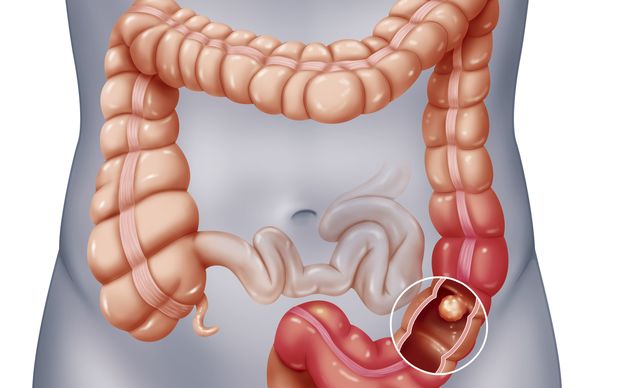
Minimally invasive methods
This treatment is a surgical intervention without the use of a scalpel or other cutting medical equipment. Such techniques include:
- infrared coagulation;
- laser coagulation;
- cryotherapy;
- ligation of the hemorrhoid using latex rings;
- sclerotherapy.
These medical procedures are carried out using laser, infrared radiation, liquid nitrogen, sclerosing medications and specialized latex rings. This allows you to remove hemorrhoidal formations with minimal damage to the rectal area and a short recovery period.
Diagnostics
It is worth clarifying that hemorrhoids (even in the most advanced form) never turn into cancer. But in order to make an accurate diagnosis, the doctor must differentiate the two diseases. For this purpose, the following diagnostic measures are carried out:
- Examination of the rectum. Both diseases are determined by touch - the doctor is able to detect any neoplasm with his fingers, establish its exact location, shape and size.
- Examination with an anoscope. This is a special instrument that is inserted into the rectum and allows you to visually assess the condition of its mucosa and walls at a depth of a maximum of 14 cm.
- Endoscopy. This procedure is called sigmoidoscopy: it allows the doctor to examine and evaluate the condition of the walls of the large intestine up to the sigmoid. If during such an examination a neoplasm is detected, then the specialist takes a fragment of the biomaterial for histological examination. This helps make an accurate diagnosis.
In addition, a proctologist can use in diagnosis:
- X-ray of the intestine using a contrast agent - irrigoscopy;
- ultrasound examination of the abdominal cavity;
- computed tomography;
- blood for tumor markers.
Cancer of the digestive system can manifest itself as mucus/pus/blood in the stool, pain and general weakness. But you won’t be able to make a diagnosis on your own, so such symptoms are a reason to visit a specialist.
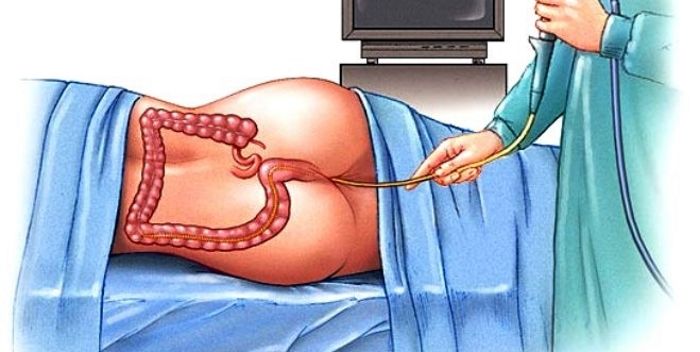
Surgery for hemorrhoids
These methods of treating hemorrhoids and colon cancer are quite similar. Surgery for hemorrhoids involves two main operations:

- Hemorrhoidectomy - cutting out all tissues that are affected by hemorrhoidal changes, as well as tissue around the anus. Certain types of surgical intervention distinguish between fixation of the mucous membrane to the underlying tissue, which is a very traumatic and painful operation with a long recovery period. But its implementation is justified in the last stages of disease development, when pathological processes have become advanced.
- Longo's operation is the cutting out of a separate section of mucosal tissue, which involves moving hemorrhoids deep into the canal, disrupting their circulatory processes. As a result, the nodes begin to die off on their own. The Longo method is a safer and faster operation with a minimal recovery period, but it is performed only for internal hemorrhoidal formations.
Instrumental research methods
In the first stages of diagnosis, in order to differentiate rectal cancer from hemorrhoids, a digital examination will be most useful. During this procedure, the doctor evaluates the pathological formations of the gastrointestinal tract outlet. The proctologist is also able to characterize the tumor, detect its location, and determine its size.
If the patient has hemorrhoids, then during a digital examination this pathology is felt as a small node located at the outlet of the rectum. Nodes can be solitary or multiple.
We recommend reading: The initial stage of hemorrhoids: what it looks like, causes, symptoms and treatment
In this case, sigmoidoscopy is very informative. With its help, the mucosa of not only the rectum, but also the distal parts of the sigmoid colon is assessed. This technique is very painful and causes great discomfort for the patient, but thanks to it the doctor can take a piece of cancer tissue for examination.
The technique in which pathological biomaterial is taken is called a biopsy. A biopsy is performed in various ways, as an independent procedure and as an addition to other instrumental studies. The essence of this manipulation is to take a section of tumor tissue for further study in the laboratory. An experienced histologist knows very well what cancer looks like under a microscope. It is able to recognize cancerous biomaterial during examination. Based on the conclusion of a histologist, the malignancy of the neoplasm is confirmed or denied.
There is a specific test for colorectal cancer, and it involves detecting tumor markers. Tumor markers are special biological compounds that are released into the blood either as a result of the activity of a tumor, or by healthy tissues in response to the activity of a malignant neoplasm.
This option may occur when multiple lesions occur involving several parts of the intestine. In such situations, irrigoscopy is most informative. In addition to instrumental examination of the digestive tract, it is necessary to diagnose other organs and systems, such as the bladder, kidneys, liver, lungs, etc.
Surgical tumor removal
Radiofrequency ablation and cryodestruction are well-tested methods for treating colorectal cancer at a non-invasive stage. However, for some types of cancer pathology, these methods are ineffective.
Transanal microscopic surgery for rectal tumors is the least traumatic method of removing a tumor lesion through the intestinal lumen. TEM is indicated for non-invasive cancer and requires high-tech equipment in the clinic.
In the later stages of the disease, the above symptoms are accompanied by the following manifestations of rectal cancer:
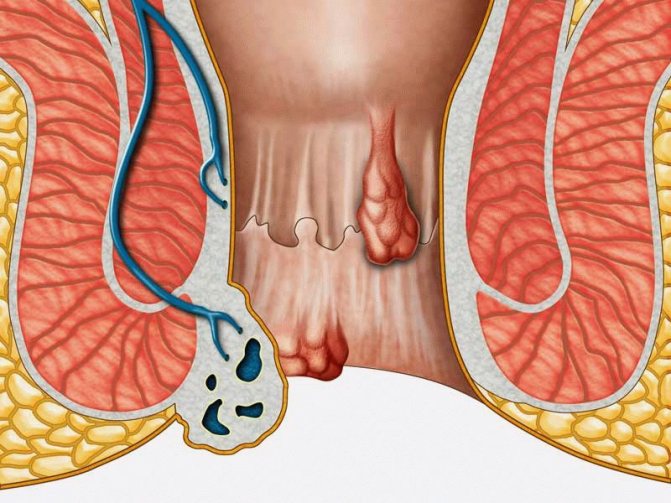
Doctors so often frighten patients with the danger of “standard” diseases degenerating into cancer that you involuntarily begin to fear your own shadow. Especially when it comes to delicate ailments, for example, such a common one as hemorrhoids. Therefore, the question of whether hemorrhoids can turn into cancer is quite natural for those who have had to face a similar diagnosis.
Haemorrhoids
Is there a relationship between hemorrhoids and cancer? Is there a real threat of hemorrhoidal malignancy? Is it necessary and when to sound the alarm? Today we will help you understand the problem in more detail and answer the question of how to distinguish hemorrhoids from rectal cancer.




